Central Place theories of Christaller & Losch | Geography Optional for UPSC PDF Download
Introduction
- The theory was given by Walter Christaller in 1933
- It is one of the 1st Locational theories in Human Geography
- Along with Von Thunen’s Agricultural Location theory & Weber’s Industrial location theory, Central Place Theory is one of the Locational Triads that became the basis of law making tradition in Quantitative Revolution phase in Geography (1950s)
- The objective of Quantitative Revolution phase was to develop Models & Theories for a more objective analysis in Geography & to make geography as one of the modern scientific discipline
- It is a normative deductive theory
- It is concerned with the way the settlements evolve and are spaced out
- It seeks to discover an order in size & spacing of settlement and functional relation between them i.e. Settlements size & its position in hierarchy, functional relation with other settlements, etc
- It seeks to find whether spacing of settlement is arbitrarily located or there is any logic or justification between order in size and spacing of settlement
- It is a theoretical account of the size and distribution of settlements within an urban system
Assumptions
The Locational Triad used the principle of simplifying assumptions to make lawmaking or to make generalizations relatively easier
- Isotropic Surface i.e. Homogeneous surface, which is flat & monotonous without any variations in physical aspects of relief, climate, terrain & resources
- The region is isolated i.e. Landscape understudy is isolated & has no connection with the rest of the world
- All men are rational & economic i.e. people with perfect knowledge & unbounded rationality
- All consumers have the same income & demand is the same
These consumers visit the nearest Central place that provides Goods & Services required by them as transport cost rises proportionally with distance.
The entire landscape of settlements is to be fully served by a set of uniformly spaced central places
All settlements are point occupying i.e. Metropolis or Normal City, town or hamlet, all occupy the equal area
The settlement distribution is uniform with respect to resources
The population is homogeneously distributed i.e. population of city, town, hamlet, metro, etc is equal
Objectives
- It consists of 2 theories
(i) W. Christaller Theory (1933)
(ii) August Losch Theory (1940) - Christaller’s theory was based on his empirical studies of settlements in South Germany
- CPT is a theory that tries to suggest that under ideal normative conditions or perfect conditions, what can be the best number of levels in which urban hierarchy can be dissolved (Tier 1, Tier 2, Tier 3 towns etc), the number of settlements in each hierarchy, their location & spacing and ideal shape of their influence area (circular, hexagonal, etc)
- Since it is a normative model, it can be used for planning
Concepts
- The Fundamental Concepts on which CPT is based are
(i) Principle of Centralization
(ii) Principle of Hierarchy - These principles govern the structure of all phenomenon
Principle of Centralization
- Similar to all matter, all regions have a core and peripheral areas
(i) e.g. The village has its core around a temple, mosque, church, chaupal, etc
(ii) e.g. Small towns serve as a core for several villages and hamlets - It is not necessary that the core/focal point has to be at the geometric centre of the settlement
- Centralization is, thus, not a geometrical concept rather a concept concerning the relationship between a central and peripheral settlement
Principle of Hierarchy
- Similar to most phenomenon arranged in a hierarchical fashion, Hierarchy also manifests itself in terms of territorial divisions and places
- e.g. State, District, and Tehsil complemented by place hierarchy of State capital, District headquarter and Tehsil headquarter
The theory is based on 6 Derivative Concepts
- Concept of Central Place
- Concept of Central Place function
- Concept of Centrality
- Concept of Complementary Area
- Concept of Threshold Population
- Concept of Range of Goods & Services
Concept of Central Place
- It is the principal settlement of any region i.e. chief/main settlement that provides goods & services of basic & regular nature to all surrounding regions depended on it(e.g. CBD)
- It is the focus point to all surrounding regions such as
(i) Around a village – Town
(ii) Around a large town, or medium city – Metro City
(iii) Around a metro city – Capital city - Any yearly or weekly market do not serve as a focal point rather a permanent settlement or establishment
- Central Place is characterized by maximum pull & a high degree of functionality (e.g. Transport, Health, Education, etc)
- It is at the helm of affairs
- In the theory, Central Place is depicted by a single dimensionless point
- However, all urban places are not necessarily urban places e.g. A mining town or manufacturing town is not a central place, unless it has some tertiary activities catering to needs of surrounding villages
Concept of Central Place Function
- These are the set of Goods & Services offered by Central Place
- A central place offers more than one central place functions & all the functions are not of same hierarchical order rather some of them are of higher hierarchy & some of lower hierarchy (e.g. Supreme Court has a higher hierarchy and it is located in Delhi)
Concept of Centrality
- Centrality refers to the relative importance of a central place which is dependent on the Central Place functions that it offers such as
(i) Number of Goods & Services
(ii) Variety of Good & Services, and
(iii) Order of function - Those which provide higher order function have high centrality whereas those which provide lower order function have low centrality
- Centrality of a central place is not on the basis of its location (Central Place is never the geometric centre)

Concept of Complementary Area
- Complementary area is the area of influence of a Central place i.e. the surrounding regions up to which central place provides its goods & services
- It would be larger for bigger and more important central places
- In theoretical sense, it is a collection of settlements of lesser importance
- In an isotropic surface, the distance decay function of every Goods & Services operates proportionally in all directions
- Distance Decay function states that the interaction between two locales declines as the distance between them increases and it is applicable for higher order functions
- In an isotropic surface, the complementary area is always a circle with the central place at the centre of this circle (i.e. there is uniformity)

Concept of Threshold Population
The minimum number of service users or customers that are required for the viability of central place functions and, therefore, the Central Place
- e.g. Minimum Population to run the primary school – Population of village sufficient
- e.g. Minimum Population to run Higher education – Large population required such as 2,3 villages
- e.g. Minimum Population to run a university – Population of up to a city required
- e.g. Civil Aviation – Population of a metro or large city
Concept Of Range of Goods & Services
- Range is the maximum distance that a person or customer is willing to travel to avail the central place functions offered at the Central Place
(i) e.g. Travel to a metro city to purchase a costly car
(ii) e.g. spinal cord injury – travel to AIIMS, cold & cough – travel to Primary Health Centre, etc - Both the Threshold & Range are the properties of goods & services offered at the central place
(i) e.g. Supreme Court at Delhi has maximum range and threshold


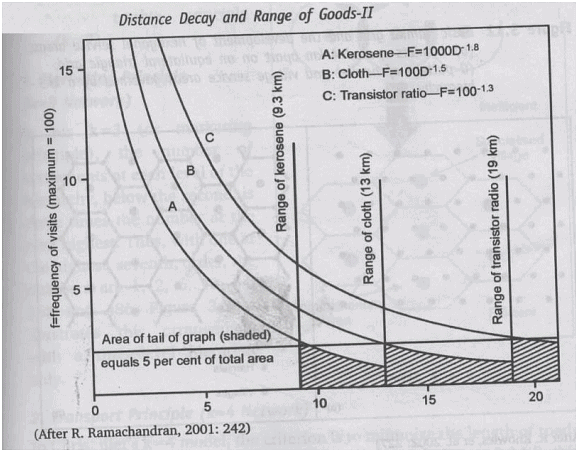
Implications of the Concepts in Resolution of Settlement Complex under Normative Conditions
- The Complementary Area should have the threshold population to make the central place viable
- The Range (i.e. the distance a consumer is willing to travel) should be equal to or more than the radius of the Complementary Area because if the range is less than the radius, the consumer may not be willing to travel from the periphery of the complementary area to avail the services at a central place
- For ideal resolution, the Range should be exactly equal to the radius of the Complementary Area & the Complementary Area should have a population exactly equal to the threshold
- For the perfect competition, neither the buyer nor seller must be at any extra disadvantage but both are economic man & both want to maximize their profits under the least cost consideration
- A buyer will reduce his costs by minimizing transportation costs. This he can do if there are the maximum number of central places to facilitate accessibility
- A seller will maximize his costs by reducing & minimizing the central places from where he operates
- The CPT is about how the number of Central Places can best arrive where neither the seller nor the buyer is at any extra advantage or disadvantage (A trade-off in the number of Central Places & in the level of hierarchies of Central Places).
- The above resolution is possible by
- The Complementary Area must have exactly the threshold level of population
- The Range must be equal to the radius of the Complementary Area
- A higher-order central place in the hierarchy must offer all the lower order functions too along with the highest order function relevant to its hierarchical level (e.g. Delhi provides higher-order functions like parliamentary and judicial functions and lower order functions like Railways )
- Circular Complementary Areas are perfect (because of the maximum area within the minimum circumference) but in circular shapes, some of the buyers will be excluded if the complementary areas all made to touch tangentially
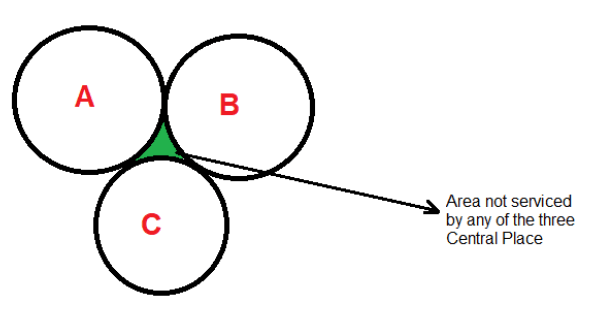
- If we want full coverage, the Complementary Areas must be made to overlap which then leads to duplication of services provided in some areas
- Christaller suggested that the next best shape in resolving the crisis is the hexagonal lattice network where the hexagonal complementary areas touch but don’t overlap and provide maximum coverage of the area.
- Hexagonal lattice do not provide advantage or disadvantage to any buyer or seller

- Settlements that are higher in the hierarchy are lower in number & are far apart (e.g. Metros such as Delhi, Mumbai, Chennai, Kolkata, etc)
- Settlements that are lower in the hierarchy are more in number & are close (e.g. Towns, Villages, etc)
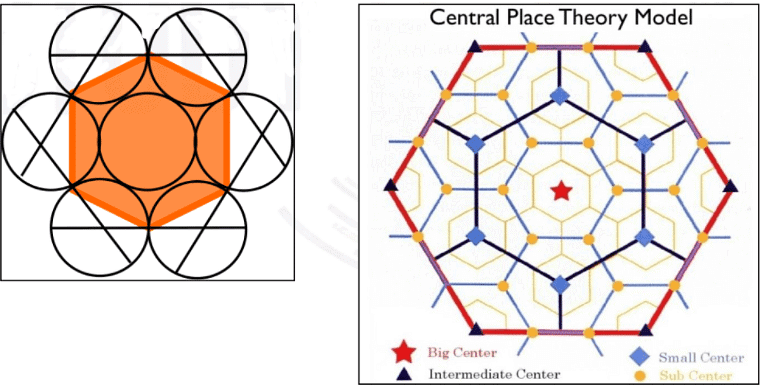
- In the Hexagon,
(i) Big Centre i.e. Metro is 1
(ii) Intermediate Centre i.e. Cities are 6
(iii) Small Centre i.e. Towns are numerous, and
(iv) sub-center i.e. Villages are still more - Hexagons of lower orders are nested within hexagons of higher orders which is known as the Nested Pattern of Hierarchy
- Christaller identified fixed relation between 2 connecting levels of hierarchy (e.g. Towns and Cities) i.e. K value
(i) K indicates the number of Complementary areas of lower-order center served by the next higher order center (including itself).
(ii) K is the ratio (except 2nd Order) in which the lower-order centers are served by the highest order central place. - He put forward 3 types of Urban Structure pattern where
K = 3
K = 4
K = 7
K=3
- In those areas where buying and selling is most important, the Urban structure would emerge in such a way that K=3 hierarchy will develop
K=4
- In those areas where transport cost improves, the Urban structure would emerge in such a way that K=4 hierarchy will develop
K=7
- In those areas where the administration is centralized, the Urban structure would emerge in such a way that K=7 hierarchy will develop
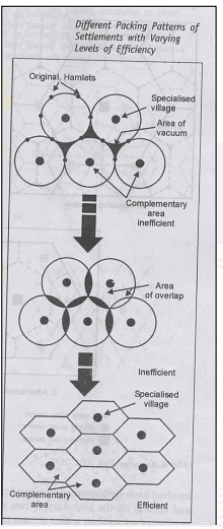
Patterns of Hierarchy
- Based on the concepts of Central Place, Christaller tried to resolve the settlement complex & suggested the possible location for central places for 3 types of function
(i) Marketing Function
(ii) Transportation Function
(iii) Administrative Function - One of the lacunae of the CPT Model is that the manufacturing function is ignored which however was corrected by August Losch.
- For every pattern of Central Place location, Christaller suggested 7 Hierarchical Levels as efficient hierarchical organizations.
Marketing Principle (K=3)
- The lower-order central places are located at the vertices of the hexagonal complementary areas of the next higher-order central place.
- Lower order settlement should be located as close as possible to higher-order settlement as to minimize the distance traveled
- In such areas, the pattern of Urban Structure will be as shown
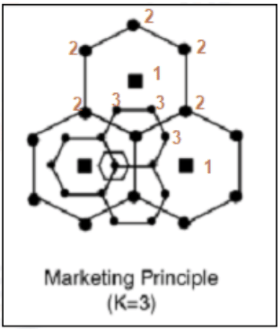
- In the given figure, 1 is a higher-order settlement and 2 is lower-order settlement whereas 2 is a higher-order settlement for 3 which is a lower order settlement
- This structure would reduce distance travelled
- Here, 6 lower-order settlements will be located around a higher order settlement (Total 7 hierarchical levels) such as 2 around 1, 3 around 2, and so on
If ‘A’ is the area of the complementary area of higher-order and ‘a’ is the complementary area of the next lower level Central Place, then
A = (6 x (1/3)a) + a
A = 2a + a, i.e. high order settlement serving the population of 2 lower order and its own
A = 3aA/a = 3 = K
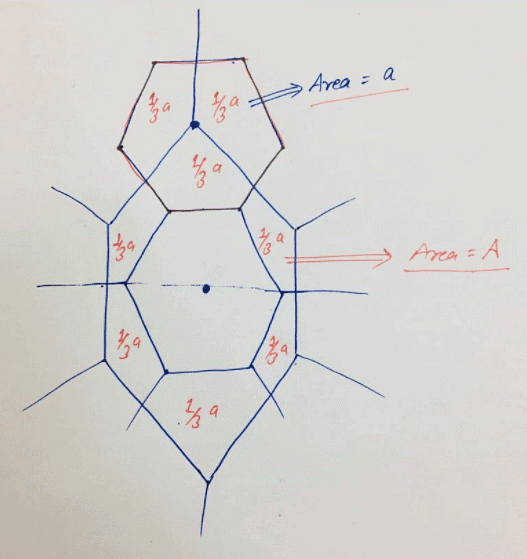
- This implies that every higher-order center supports 3 next lower order centers
- Thus,
Highest order centre = 1
Next Lower Order center = 3
Next lower-order = 9
Next lower-order = 27 & so on till VII - In K=3, the number of Central Places is minimized to benefit both the service providers & buyers
Transportation Principle (K=4)
- According to Christaller, for transportation resolution of space, the lower order centers must be located at the midpoint of the sides of the higher-order complimentary area.
- The criteria is to minimize the length of roads to join all adjacent pairs of central places
- Here, the lower-order center is not on the apex but on midpoints of sides to ensure the maximum number of settlements lie on a straight line route.
- Thus, each settlement is on the boundary of two rather than three hexagons
A = (6 x (1/2)a) + a
A = 3a + a
A = 4a
A/a = 4 = K
- K=4 implies that a higher-order center can support 4 next lower level centres
- In K=4 principle, the length of the road is such that it connects the maximum number of Central Places
- Route that connects higher order centre also have lower order centre on them to minimize the transportation cost
- Each lower-order centre is equidistant from only 2 higher-order centre, so the population gets divided into half
- Each higher-order centre is surrounded by 6 lower-order centre
- Thus, a higher-order centre is serving the complimentary area of 3 lower-order centre and its own area i.e. A = 3a + a = 4a
Administrative Principle (K=7)
- It develops in areas of highly centralised administration
- For efficient administration, there must be no duplication of decision making and that’s possible when the lower order complementary areas are nested entirely within the higher order complementary areas
- Here, the higher order settlement serves complementary areas of all 6 lower order settlement
- Thus, shared element is eliminated
- This K=7 i.e. 6+1 , which implies that each higher order centre supports 7 next lower level centres or higher order centre supports entire complementary area of 6 lower order and its own area
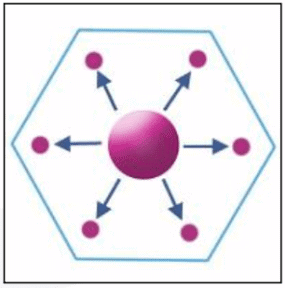
Evaluation
Positives
- One of the Locational Triads
- Basis of many models in Human Geography
- Innovative concepts of Normative assumptions
- The models have been used for urban planning and the hexagonal lattice network is the principle in which cell phone operators divide the mobile communication areas
- It provides the rationale for efficient division of space & function
- It was first-time such theory was put forward
- CPT has been used as an integral part of planning in countries like Germany where reclaimed land from sea used CPT for relocating settlements
- It helps us in identifying the role of settlement as a place of trade exchange & extent to which this has influenced the nature of emerging settlement pattern in any region
- It tries to seek some order in spacing & interrelationship of settlements i.e. Settlements not `arbitrarily located but there is logic & rationality behind their location
Applicability to India
- Christaller suggested 7 levels of hierarchy but for administration in India, there are 6 levels
(i) National Capital
(ii) State Capital
(iii) District Headquarter
(iv) Tehsil Town
(v) Block Level
(vi) Gram Panchayat which may itself include one or more revenue villages - This is closest to Christaller’s perfection
- For administrative principle, K=7, but India has 28 states and 8 Union Territories i.e. 36 entities
- Every state has, on average, 15-20 districts
- There are more than 6 lakh villages, so in the case of India, Applicability is quite difficult.
- In India, while determining the capital of Telangana, CPT was used.
Limits
- A normative theory based on simplifying assumptions will never depict reality. It gives a false sense of Objectivity and is not practically applicable as it is in the real sense.
- An Isotropic Surface is rarely found in real world
- Behaviour of consumer & seller not always rational
- Man not always an optimizer rather he is a satisfier
- The hexagonal pattern of the central place is rarely found (Region up to which goods & services provided by central place)
- The theory is suitable primarily for agricultural regions because modern factors such as communication, transport, etc. have reduced the distance between buyer and seller. Rather, the world has been reduced to the level of a village
- It ignores manufacturing which is one of the most Central Place functions
- The fixed value of K gives a poor approximation of reality and
(i) K=3, Buying and selling important
(ii) K=4, Transport
(iii) K=7, Administrative,
(iv) All take place together in real-world in Urban areas
Loschien Landscape/Modification
- Christaller’s model has been modified by an economist & geographer with a view to render this model practical & applicable to the real world.
- It was given by August Losch through the study of Iowa State in 1940.
- His model has an empirical inductive approach and provides a moderate critic (since he accepts many parts of Christaller).
- It was also the first attempt to develop a general theory of location with a major emphasis on demand
Assumptions
- He simplified the world to a flat uniform plain and held supply constant and assumed that demand for produce decrease with an increase in price. If a Price increase was the result of an increase in transportation cost, then demand of the product would decrease with distance from a production center. Losch treated each function as having a separate range, threshold, and hexagonal hinterland.
- Based on the Urban places of entire Germany in which he took consideration of 150 Goods & Services
- He sought to explain the size and shape of market areas within which a location would command the largest revenue
- The basis of concepts of Losch was much similar to those of Christaller original theory i.e.
- Based on Normative assumptions
- Isotropic surface, rational & economic man
- The basic concept of threshold, range, complementary were the same
- The hexagonal lattice pattern was also used by Losch as the best approximation towards the circle
- However, he raised objections to
- The variability of ‘K’ which denotes the centrality
He has allowed ‘K’ to vary freely which means that it is different for various goods & services - Losch considered 150 Goods & services and was antithetical to the overgeneralization of Goods & Services into 3 principles
- He prepared 150 Hexagons for the selected Goods & Services and superimposed them with higher-order at the base and lowest order at the top and rotated all the hexagons until the rich and poor sectors have emerged – such sectors were demarcated on the basis of the cost of commodity or services.
- Thus, Losch suggested a nesting pattern for 150 functions & therefore, a much extensive, continuous values of K & not just 3 values (3,4,7)
- Although the surface is isotropic, Losch suggested that the distribution of Central Place is not really uniform.
- Central Place & Service providers agglomerate to benefit from economies of Scale (i.e. when the scale of service becomes bigger, costs are shared) such as Common labour market, common customer base, and sometimes common infrastructure & raw material needs
- Therefore, there is a tendency where certain regions specialize in some types of function and services such that type of services & goods may not be available in other parts of the settlement complex.
- He found that Central place as the primate city (main dominant city) located in the center of a circle & the circle was divided into alternate bands of 12 sectors – 6 city rich sectors and 6 city poor sectors implying that city rich regions have an agglomeration of certain function and city poor will have relatively less of these function.
- Transportation lines radiate from the center & many hierarchies of settlements interwoven together (For eg- Delhi Metro).
- The landscape so produced has a densely populated & congested settlement pattern with greater randomness & spatial organization of Christaller is absent.
- This model is more applicable to the underdeveloped & developing landscape and 3rd world countries.
- His model is based on demand & production of various Goods & Services which are concentrated in Metropolis.
Merits
- Removes limiting constraints from Christaller’s model allowing more variation in threshold sphere of influence & K values (providing practical applicability in today’s scenario).
- Does not assume that settlement is based only on 3 aspects of Marketing, Transport & Administration functions but by Combination of many (150 Goods & Services & developed over 40 networks)
- Maximum purchases would be made locally.
Criticism
- Overemphasis on demand
- Abstract Nature and failure to take into consideration the problems arising from the locational interdependence of manufacturing industries & plants
- Complicated & difficult to understand but it is more close to reality
- Overlapping of networks creates the problem of cartographic representation and are difficult to understand
- CPT – applicable to those countries with sparse populations and Losch – with dense populations.
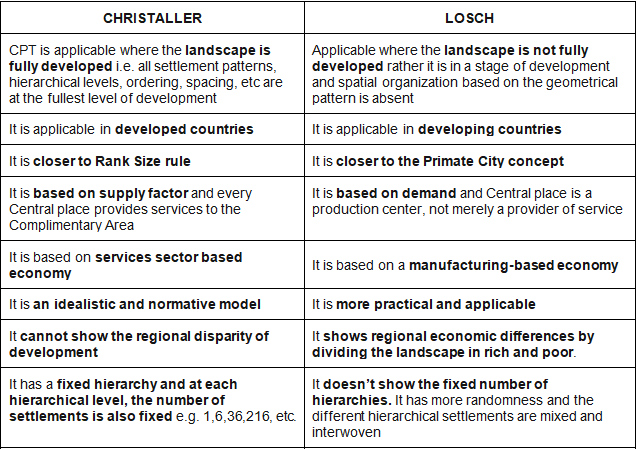
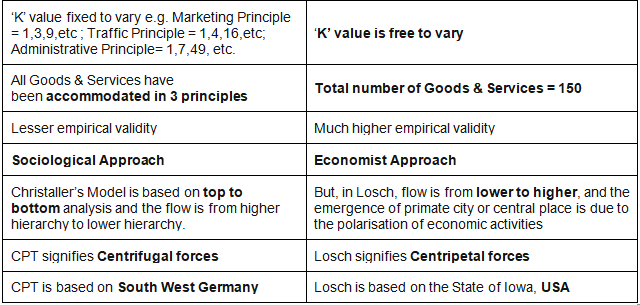
Critical Evaluation of Christaller
- The normative models can’t have a universal application (based on assumptions & doesn’t include dynamism & subjectivity) but they are used as parameters to measure the reality and deviations from it
- Such models are measured on 2 principles
(i) Principle of Desirability: whether such models are desirable or not
(ii) Principle of Universal Applicability: How far applicable - Such models are highly desirable since they provide scientific temperament and structure to the subject matter
- These models are Stochastic laws (half-true), which reveal the reality and the unreal at the same time
- Their basic principles/tenets are unquestionable
- However, universal validity must not be sought as they are based on idealistic and normative principles
- In the critical evaluation, the modifications introduced by Losch reflect the major discrepancies of Christaller e.g. the fixed variability of ‘K’, supply-based model instead of demand-based, complex nesting pattern, space geometry, gross generalization of Goods & Services into 3 principles
Application
- Too idealistic to be found in real-world but has applicability in developed countries, where Rank Size Rule is found
- Countries with the larger geographical area, higher economic development, the service-based economy can have a resemblance of this model e.g. USA, Germany, France, etc
- In India, the marketing principle is applicable at the district level hierarchy. The tehsil towns have 1/3rd of their population moving into the district town for higher-order Goods & Services.
- For the administrative principle, It has the same number of hierarchy as envisaged by the CPT
- In India
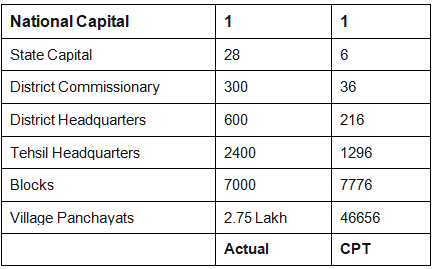
- Thus, it is applicable at Block Level, where the number of sellers are similar as in CPT
- Practical Aspect
- According to Qazi Ahmed, CPT is not applicable in India because it is in the developing stage
- The physiographic and climatic diversity do not allow this model to be practically applicable
- R. L. Singh has concluded that CPT has partial applicability from District to Panchayat level i.e. in the lower hierarchy.
- In a higher hierarchy, it is not applicable due to geographical area, which comes with metropolitan polarisation, or representative of their regional primacy
- R. P. Mishra stated that CPT can be applied if the landscape is fully developed, both in terms of economy and demography
- India being in the stage of development is far away from the application of this model
- The Loschien modification is, however, more applicable, at least in the few quadrants of India.
|
304 videos|717 docs|259 tests
|
FAQs on Central Place theories of Christaller & Losch - Geography Optional for UPSC
| 1. What are Central Place theories of Christaller & Losch? |  |
| 2. What is the significance of Central Place theories in urban planning? |  |
| 3. How do Christaller & Losch's Central Place theories explain the hierarchy of central places? |  |
| 4. How do Central Place theories explain the spacing of central places? |  |
| 5. Can Central Place theories be applied to modern urban planning? |  |





















